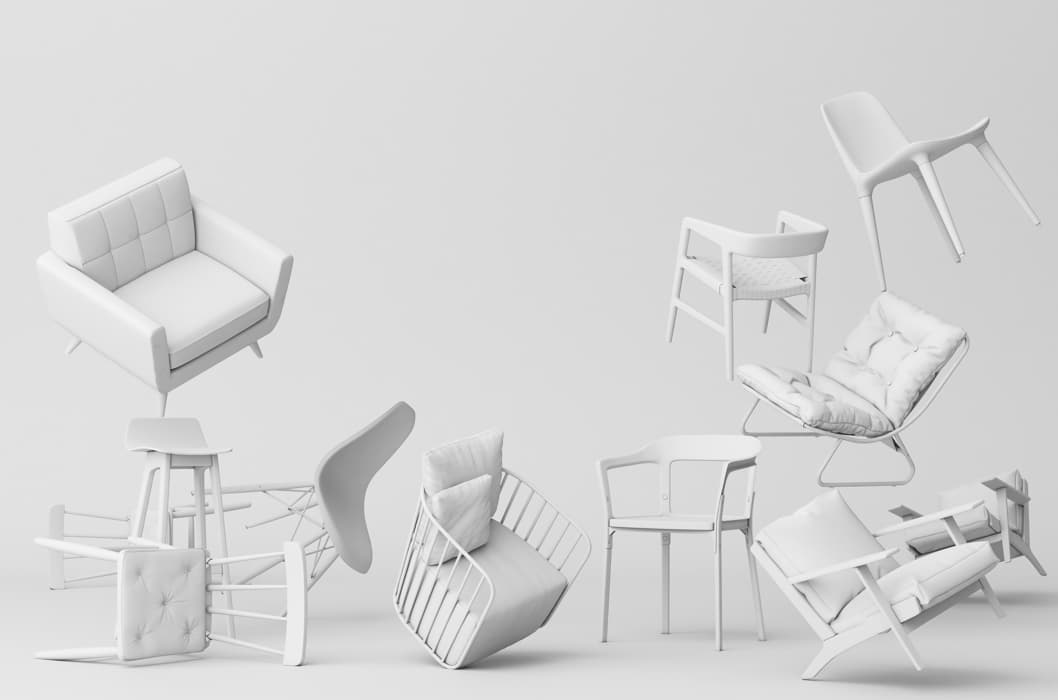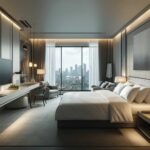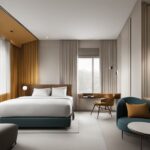In the modern furniture industry, 3D Renderings in Furniture Design have revolutionized the way furniture is conceptualized, visualized, and produced. This photo-realistic technology enables designers and manufacturers to create detailed virtual models, making customization, revisions, and production planning significantly more efficient.
By leveraging 3D rendering technology, companies can eliminate guesswork, reduce production errors, and accelerate project approvals. In this article, we explore why 3D Renderings in Furniture Design have become a game-changer in the industry, helping designers and manufacturers bring ideas to life with precision and efficiency.
Table of Contents
Toggle- Why Do We Use 3D Renderings in Furniture Design?
- Improved Communication and Design Accuracy
- 3D Rendering Assists in Structural Modifications
- Designers Gain Confidence with 3D Visualization
- 3D Rendering Enhances Smart Furniture Integration
- 3D Renderings Reduce Errors and Miscommunication
- Marketing Advantages of 3D Furniture Renderings
- Final Thoughts
- The Advantages of Custom Luxury Hotel Furniture
- The Importance of Custom Hotel Furniture in Enhancing Guest Experience
- The Ultimate Guide to Finding Top Hotel Furniture Suppliers in Turkey
- Importance of High Quality Furniture in Hotels
- The Impact of Furniture Design on Hotel Guest Experience
- High Quality Furniture in Hotels: Essential for Guests
- The Role of Furniture in Defining Hotel Aesthetics
- The Evolution of Hotel Furniture Design Over the Years
- How to Choose the Right Upholstery for Hotel Furniture
- The Impact of Furniture Design on Guest Experience in Hotels
- Hotel Furniture and Design: Enhancing the Guest Experience
- Premium Hotel Furniture in Turkey: Elevate Your Hotel’s Interior Design
- How Do Hotels Get Furniture in the Rooms | Hotel Solutions
- Hotel Furniture Concept | Perfect Products for Your Hotel
- Top 5 Benefits of Turkish Made Hotel Furniture
- What makes a good faux leather?
- Furnishing an Apartment: 6 Tips for Choosing the Best Furniture
- Types Of Hotel Furniture You Need
- Why Turkish Made Hotel Furniture is the Best Choice for Your Business
- What is fixed furniture?
- Maximizing Your Hotels ROI with High-Quality Furniture Solutions
- Benefits of Custom Made Furniture
- Hotel Furniture Buying Guide
- Where Do I Buy Hotel Furniture in Turkey?
- How to Make a Hotel Room Feel Like Home
- How Often Do Hotels Change Their Interiors?
- A Good Hotel Furniture Manufacturer
- 7 Signs Your that Hotel Needs Renovation
- What Factors Will Affect Hotel Furniture Prices?
- Should I Buy Laminate or Veneer Furniture?
- MDF Cutting Machine
- What are the Basic Furniture Required to Set Up a Hotel?
- What is Crib 5?
- Four Ways to Maintain Hotel Room Storage
- Characteristics of a Custom Hotel Furniture
- Popular Materials for Luxury Hotel Furniture Manufacture
- The Four Characteristics of a Hotel Furniture Design
- 4 Key Considerations for Hotel Furniture
- Hospitality Design Mistakes That Are Common
- Hotel Furniture Quality Control Checklist
- Things Your Hotel Furniture Manufacturer Should Provide
- Advantages of Custom Hotel Furnitures
- Important Questions to Ask a Potential Hotel Furniture Supplier
- What Are the Guides to Contract Furniture?
- Things to Consider When Choosing a Hotel Furniture Manufacturer
- Wood Veneers and Laminate Casegoods
- Wooden Furniture Care
- What Types Of Wood Are The Best For Your Luxury Sofa?
- Hotel Furniture Cushion Upholstery Care
- Leather Furniture Care; Maintaining Your Hotel Furniture
- Ten Tips for Hotel Lobby Design
- Starland Hotel Cameroon
- Hotel Furniture Turkey
- The Best Hotel Furniture Suppliers
- Hotel Furniture Manufacturers in Turkey
- Four Mistakes While Buying a Restaurant Furniture in Turkey 2021
- Selecting Booth and Sofa Seating Made in Turkey
- 10 Restaurant And Cafe Furniture Ideas From Turkey
- Five Most important Materials in Hotel Furniture Industry
- Hotel Renovations: Luxury Hospitality Furnishings made in Turkey
- How to Maintain Hotel Furniture for 10+ Years
- Commercial VS Residential Furniture Made in Turkey
- Hotel Furniture Manufacturing Industry in Turkey
Why Do We Use 3D Renderings in Furniture Design?
Significant Cost Savings with 3D Renderings
One of the primary benefits of 3D Renderings in Furniture Design is cost-effectiveness. Understanding every aspect of a furniture piece before production helps identify potential design flaws, reducing the likelihood of expensive post-production modifications.
With 3D modeling in furniture, designers can generate realistic visualizations that highlight any structural weaknesses, ensuring efficient use of materials and minimizing waste. This not only saves money but also improves sustainability in furniture manufacturing.
Enhancing Furniture Visualization with CAD Drawings
3D Renderings in Furniture Design allow for detailed and customizable CAD drawings. Designers frequently send concept sketches, but before transitioning to construction drawings, a 3D rendering is created to fully grasp the spatial and aesthetic aspects of the furniture.
This process ensures that designers, manufacturers, and clients are aligned on expectations, leading to a smoother production process and a better final product.
Improved Communication and Design Accuracy
Using realistic furniture rendering, designers can visualize how a piece will appear in a real-world setting. This eliminates misinterpretations and provides a clearer representation of design elements such as:
- Dimensions and proportions
- Textures and material finishes
- Lighting and color schemes
By presenting a photorealistic image, clients and manufacturers gain confidence in the design, reducing back-and-forth modifications and accelerating approval timelines.
3D Rendering Assists in Structural Modifications
At times, hotels and interior designers require structural adjustments to furniture for guest comfort and functionality. 3D Renderings in Furniture Design allow manufacturers to test alterations virtually before committing to physical changes.
For example, if a Turkish hotel furniture manufacturer needs to modify a bed frame for better support, a 3D rendering can illustrate the adjustment and help secure designer approval.
Designers Gain Confidence with 3D Visualization
One of the most significant advantages of 3D Renderings in Furniture Design is the boost in designer confidence. With a pre-production visual, designers can ensure that:
- The furniture piece fits proportionally within a space.
- The scale and size are appropriate for the intended setting.
- The selected materials and colors align with the design vision.
By previewing the final furniture layout digitally, designers can make informed choices and reduce last-minute design revisions.
3D Rendering Enhances Smart Furniture Integration
With the rise of smart technology in furniture, designers need a way to visualize technological components within their pieces. 3D modeling in furniture allows designers to strategically place built-in technology such as:
- Wireless charging ports
- LED lighting systems
- Hidden storage compartments
By incorporating technology within 3D furniture prototypes, designers can test how technology will fit, function, and blend within the overall aesthetic of the piece.
3D Renderings Reduce Errors and Miscommunication
A major challenge in traditional furniture design is miscommunication between designers, manufacturers, and clients. 3D Renderings in Furniture Design solve this issue by offering a clear, realistic depiction of how the final product will look.
This process is especially helpful when working with complex shapes and curves that may be difficult to interpret through flat CAD drawings. By visualizing every design aspect in 3D, production teams can avoid costly errors and maintain design integrity.
Marketing Advantages of 3D Furniture Renderings
Beyond production, 3D Renderings in Furniture Design offer significant marketing benefits. Hotels, designers, and furniture brands can use high-quality 3D images to:
- Showcase new furniture collections before manufacturing.
- Create engaging website visuals to attract customers.
- Produce realistic digital catalogs without physical prototypes.
Hotels can also use digital furniture rendering to preview interior renovations, helping potential guests visualize their stay and boosting booking rates.
Final Thoughts
3D Renderings in Furniture Design have become an indispensable tool for designers, manufacturers, and hospitality professionals. From cost savings and better visualization to reducing design errors and aiding marketing efforts, this technology enhances every step of the furniture design process.
By leveraging 3D furniture prototyping and CAD renderings, businesses can ensure efficient production, better communication, and visually stunning furniture pieces that align with customer expectations.



